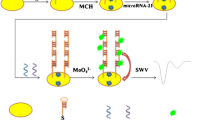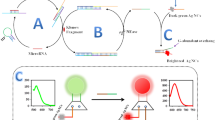Abstract
Nowadays, considerable efforts are focused on advancing DNA detection methods, which are extremely important in clinical diagnostics, pathogen determination, gene therapy, and forensic analysis. A one-pot sensitive microplate-based chemiluminescent assay coupled with catalytic hairpin assembly (CHA) amplification for detection of a 35-mer DNA oligonucleotide was developed. To improve the assay sensitivity, a triple amplification strategy based on the application of CHA (1), streptavidin-polyperoxidase conjugate (Stp-polyHRP) (2), and an enhanced chemiluminescent reaction (3) was used. The one-pot format of the assay, where all steps of the DNA determination are performed in the same well without transfer of samples from one test tube to another, increased its precision. The proposed assay detected the target DNA in the fM range and distinguished the target DNA from related DNAs, demonstrating its high sensitivity and high selectivity. Moreover, the assay was applied successfully for the quantitative determination of the target in spiked samples of human plasma. A microplate format of the assay was convenient for the analysis of a large number of samples. This study provides a prospective tool for DNA detection.

Graphical abstract






Similar content being viewed by others
References
Condoluci A, Rossi D. The future of cell-free DNA testing to guide therapeutic decisions in B-cell lymphomas. Curr Opin Hematol. 2019;26:281–7.
Sforza S, Corradini R, Tedeschi T, Marchelli R. Food analysis and food authentication by peptide nucleic acid (PNA)-based technologies. Chem Soc Rev. 2011;40:221–32.
Jung IY, Lee EH, Suh AY, Seung Jin Lee SJ, Lee H. Oligonucleotide-based biosensors for in vitro diagnostics and environmental hazard detection. Anal Bioanal Chem. 2016;408:2383–406.
Valentini P, Pompa PP. A universal polymerase chain reaction developer. Angew Chem Int Ed. 2016;55:2157–60.
Zhao Y, Chen F, Li Q, Wang L, Fan C. Isothermal amplification of nucleic acids. Chem Rev. 2015;115:12491–545.
Yan L, Zhou J, Zheng Y, Gamson AS, Roembke BT, Nakayama S, et al. Isothermal amplified detection of DNA and RNA. Mol BioSyst. 2014;10:970–1003.
Tripodi L, Witters D, Kokalj T, Huber HJ, Puers R, Lammertyn J, et al. Sub-femtomolar detection of DNA and discrimination of mutant strands using microwell-array assisted digital enzyme-linked oligonucleotide assay. Anal Chim Acta. 2018;1041:122–30.
Choi HMT, Chang JY, Trinh LA, Padilla JE, Fraser SE, Pierce NF. Programmable in situ amplification for multiplexed imaging of mRNA expression. Nat Biotechnol. 2010;28:1208–14.
Li B, Ellington AD, Chen X. Rational, modular adaptation of enzyme-free DNA circuits to multiple detection methods. Nucleic Acids Res. 2011;39:e110.
Chang C-C, Chen C-P, Chen C-Y, Lin C-W. DNA base-stacking assay utilizing catalytic hairpin assembly-induced gold nanoparticle aggregation for colorimetric protein sensing. Chem Commun. 2016;52:4167–70.
Tang S, Gu Y, Lu H, Dong H, Zhang K, Dai W, et al. Highly-sensitive microRNA detection based on bio-bar-code assay and catalytic hairpin assembly two-stage amplification. Anal Chim Acta. 2018;1004:1–9.
Zhang K, Zhang N, Zhang L, Wang H, Shi H, Liu Q. Label-free impedimetric sensing platform for microRNA-21 based on ZrO2-reduced graphene oxide nanohybrids coupled with catalytic hairpin assembly amplification. RSC Adv. 2018;8:16146–51.
Cai W, Xie S, Tang Y, Chai Y, Yuan R, Zhang J. A label-free electrochemical biosensor for microRNA detection based on catalytic hairpin assembly and in situ formation of molybdophosphate. Talanta. 2017;163:65–71.
Li X, Dou B, Yuan R, Xiang Y. Mismatched catalytic hairpin assembly and ratiometric strategy for highly sensitive electrochemical detection of microRNA from tumor cells. Sensors Actuators B. 2019;286:191–7.
Wang S, Zhang F, Chen C, Cai C. Ultrasensitive graphene quantum dots-based catalytic hairpin assembly amplification resonance light scattering assay for p53 mutant DNA detection. Sensors Actuators B. 2019;291:42–7.
Han F, Zhao J. Colorimetric fluoride-anion sensor based on intramolecular hydrogen bonding and enol–keto tautomerization of a phenothiazine derivative. Helv Chim Acta. 2008;91:635–45.
Kulmacz RJ. Prostaglandin H synthase and hydroperoxides: peroxidase reaction and inactivation kinetics. Arch Biochem Biophys. 1986;249:273–85.
Sakharov IY, Demiyanova AS, Gribas AV, Uskova NA, Efremov EE, Vdovenko MM. 3-(10′-Phenothiazinyl)propionic acid is a potent primary enhancer of peroxidase-induced chemiluminescence and its application in sensitive ELISA of methylglyoxal-modified low density lipoprotein. Talanta. 2013;115:414–7.
Kolosova AY, Sakharov IY. Triple amplification strategy for the improved efficiency of a microplate-based assay for the chemiluminescent detection of DNA. Anal Lett. 2019;52:1352–62.
Bodulev OL, Gribas AV, Vdovenko MM, Sakharov IY. Microplate chemiluminescent assay for HBV DNA detection using 3-(10′-phenothiazinyl)propionic acid/N-morpholinopyridine pair as enhancer of HRP-catalyzed chemiluminescence. Anal Biochem. 2018;543:33–6.
Dong G, Dai J, Jin L, Shi H, Wang F, Zhou C, et al. A rapid room-temperature DNA amplification and detection strategy based on nicking endonuclease and catalyzed hairpin assembly. Anal Methods. 2019;11:2537–41.
Ji D, Mou X, Kwok CK. Label-free and ratiometric detection of microRNA based on target-induced catalytic hairpin assembly and two fluorescent dyes. Anal Methods. 2019;11:4808–13.
Hun X, Meng Y, Wang SS, Zhang H, Luo XL. Mismatched catalytic hairpin assembly coupling hydroxylamine-O-sulfonic acid as oxide for DNA assay. Sensors Actuators B. 2018;254:347–53.
Jiang Z, Wang H, Zhang X, Liu C, Li Z. An enzyme-free signal amplification strategy for sensitive detection of microRNA via catalyzed hairpin assembly. Anal Methods. 2014;6:9477–82.
Wang WJ, Nie AX, Lu ZC, Li JJ, Shu MB, Han H. Catalytic hairpin assembly-assisted lateral flow assay for visual determination of microRNA-21 using gold nanoparticles. Microchim Acta. 2019;186:661.
Komori M, Komiya K, Shirakawa T, Morikawa TJ, Yoshimura T. Measurement of microRNA with isothermal DNA amplification on fully automated immunoassay analyzers. Anal Bioanal Chem. 2019;411:3789–800.
Funding
This investigation was financially supported by the Russian Science Foundation (Grant No. 17-14-01042).
Author information
Authors and Affiliations
Corresponding author
Ethics declarations
The research was approved by the Ethical Committee of the Russian Cardiology Research Center (Moscow, Russia). Informed consent was obtained from all individual participants included in the study.
Conflict of interest
The authors declare that they have no conflict of interest.
Additional information
Published in the topical collection Euroanalysis XX with guest editor Sibel A. Ozkan.
Publisher’s note
Springer Nature remains neutral with regard to jurisdictional claims in published maps and institutional affiliations.
Electronic supplementary material
ESM 1
(PDF 101 kb)
Rights and permissions
About this article
Cite this article
Bodulev, O.L., Burkin, K.M., Efremov, E.E. et al. One-pot microplate-based chemiluminescent assay coupled with catalytic hairpin assembly amplification for DNA detection. Anal Bioanal Chem 412, 5105–5111 (2020). https://doi.org/10.1007/s00216-020-02438-6
Received:
Revised:
Accepted:
Published:
Issue Date:
DOI: https://doi.org/10.1007/s00216-020-02438-6




